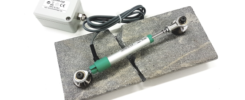An RFID tag is an electronic component made up of a chip and a small antenna. The tag has a small memory that can contain data and it has the ability to transmit them without the need of power, exploiting the energy that the antenna absorbs when it is illuminated by an RFID reader.
In the case of small-scale goods, the problem to be faced is the, extremely limited, space available to apply the tag. Murata, a Japanese company that has gained excellent know-how in the development of multi-layer ceramic substrates, has created a new RFID tag, MAGICSTRAP tag, really tiny, but at the same time robust and resistant, which can be affixed or integrated into objects of small surfaces. The tag that occupies an area of 1.25 mm and has a height of just 0.55 mm, is ideal for use in many wearable accessories, including glasses and watches, as well as numerous industrial applications such as the identification of test specimens.

In particular, it can be used not only to identify the products during the manufacturing process, but also to ensure traceability in the after-sales stage. This is a valuable support for both companies and consumers, against counterfeiting attempts and helps protect the business brand
What are its main applications?
- For electronic equipment management;
- For smartphone reading;
- For small product management;
- For clothing management;
- On metal surface.
What needs has Murata expressed to us?
Murata needed to optimize the operations of reading and writing on MAGICSTRAP tags with mobile RFID readers too.
In order to cope with the need expressed by the Japanese colossus, we have developed a custom version of our BlueBerry UHF RFID Reader. The device has been equipped with an external loop antenna that can achieve a more powerful reading.
So as you can see from the videos above our Blueberry UHF is easily able to read the MAGICSTRAP tag emebbedded on metal surface.

